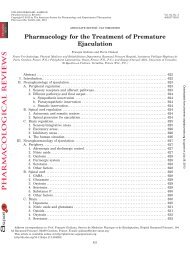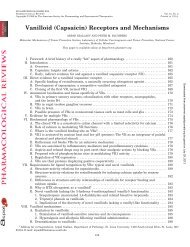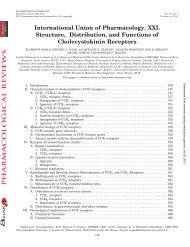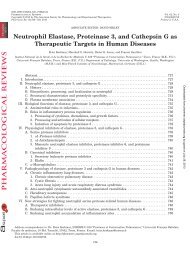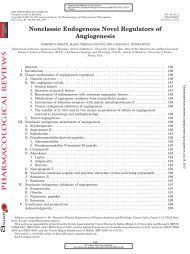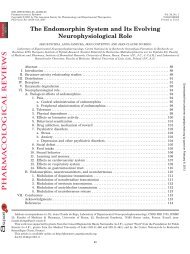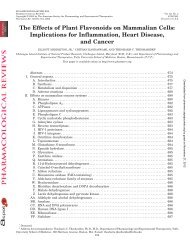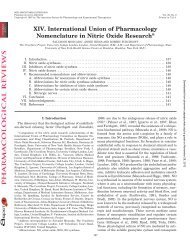Opioids, Reward and Addiction: An Encounter of Biology ...
Opioids, Reward and Addiction: An Encounter of Biology ...
Opioids, Reward and Addiction: An Encounter of Biology ...
You also want an ePaper? Increase the reach of your titles
YUMPU automatically turns print PDFs into web optimized ePapers that Google loves.
ell, 1973; Lorens, 1976). This delayed facilitation is enhanced<br />
<strong>and</strong> present earlier after repeated injection <strong>of</strong><br />
morphine (Adams et al., 1972; Kelley <strong>and</strong> Reid, 1977;<br />
Schaefer <strong>and</strong> Holtzman, 1977). Using a procedure in<br />
which the stimulus frequency <strong>of</strong> the electrical current is<br />
varied yielding a response rate-frequency function that<br />
resembles the traditional pharmacological doseresponse<br />
curve, morphine induced a leftward shift <strong>of</strong> the<br />
response rate-frequency function, indicating facilitation<br />
<strong>of</strong> ICSS (Rompré <strong>and</strong> Wise, 1989; Bauco et al., 1993;<br />
Carlezon <strong>and</strong> Wise, 1993a; Wise, 1996). In tolerant animals,<br />
an enhancement <strong>of</strong> ICSS has consistently been<br />
found (Lorens <strong>and</strong> Mitchell, 1973; Bush et al., 1976;<br />
Weibel <strong>and</strong> Wolf, 1979; Van Wolfswinkel et al., 1985).<br />
The facilitation <strong>of</strong> ICSS by morphine is mimicked by<br />
other opioids administered systemically, as shown by<br />
experiments in which heroin, 6-acetylmorphine, methadone,<br />
levorphanol, or pentazocine was tested (Kornetsky<br />
et al., 1979; Weibel <strong>and</strong> Wolf, 1979; Bozarth et al., 1980;<br />
Stutz et al., 1980; Gerber et al., 1981; Preshaw et al.,<br />
1982; Schenk <strong>and</strong> Nawiesniak, 1985; Hubner <strong>and</strong> Kornetsky,<br />
1992). The facilitation <strong>of</strong> ICSS appeared to be<br />
stereoselective in that dextrorphan did not enhance<br />
ICSS, <strong>and</strong> opioid antagonists blocked the effect (Weibel<br />
<strong>and</strong> Wolf, 1979). Thus, opioid receptors are probably<br />
involved in the opioid-induced facilitation <strong>of</strong> ICSS.<br />
From the data, it can be concluded that morphine <strong>and</strong><br />
other opioids can facilitate ICSS reward <strong>and</strong> that no<br />
tolerance developed for the facilitating effect <strong>of</strong> morphine.<br />
Depending on the procedure used, an initial depression<br />
<strong>of</strong> behavior is present in morphine-naive animals,<br />
but tolerance to this probably nonreward-related<br />
effect develops upon repeated drug administration.<br />
In experiments in which systemically administered<br />
morphine facilitated ICSS, the electrodes were in general<br />
implanted in the MFB/LH area or in the VTA.<br />
Although a direct comparison between these areas with<br />
respect to morphine action has not been performed, the<br />
obtained data are quite comparable: doses <strong>of</strong> morphine<br />
around 1 mg/kg <strong>and</strong> higher facilitated ICSS. In some<br />
studies other brain sites have been studied. When the<br />
electrodes were implanted in the medial prefrontal cortex,<br />
locus ceruleus, dorsal raphe nucleus, or mesencephalic<br />
central gray, similar effects <strong>of</strong> morphine were<br />
found (Lorens, 1976; Liebman <strong>and</strong> Segal, 1977; Esposito<br />
et al., 1979; Jackler et al., 1979; Nelson et al., 1981;<br />
Schenk et al., 1981). But a facilitation <strong>of</strong> ICSS by morphine<br />
was not present when the electrodes were implanted<br />
in the substantia nigra or in the medial part <strong>of</strong><br />
the anterior prefrontal cortex (Nazzaro et al., 1981; Corbett,<br />
1992). Thus, not all sites from which ICSS behavior<br />
can be elicited seem to be influenced by systemically<br />
administered morphine.<br />
The facilitating effect <strong>of</strong> systemically administered<br />
opioids was mimicked when relatively low doses <strong>of</strong> morphine<br />
or levorphanol, but not dextrorphan, were injected<br />
directly into the brain ventricle, implicating central opi-<br />
OPIOIDS, REWARD AND ADDICTION 363<br />
oid receptors in this opioid action (Weibel <strong>and</strong> Wolf,<br />
1979; Shaw et al., 1984). A number <strong>of</strong> studies have<br />
addressed the site <strong>of</strong> action <strong>of</strong> morphine <strong>and</strong> other opioids<br />
in facilitating ICSS behavior. Morphine (1 g) injected<br />
bilaterally into the ventral tegmental/substantia<br />
nigra area but not in the NAC or the striatum facilitated<br />
ICSS behavior elicited from electrodes placed in the<br />
MFB (Broekkamp <strong>and</strong> Van Rossum, 1975; Broekkamp<br />
et al., 1976; Broekkamp <strong>and</strong> Phillips, 1979). Morphine<br />
was effective at a dose <strong>of</strong> 200 ng, but not <strong>of</strong> 50 ng, <strong>and</strong> the<br />
drug effect was blocked by systemically administered<br />
naloxone. The effect <strong>of</strong> morphine was mimicked by injection<br />
<strong>of</strong> [D-Ala 2 ]-Met-enkephalinamide into the same<br />
area. A dose-dependent decrease in the frequency<br />
threshold for ICSS from the MFB was found after injecting<br />
morphine into the VTA (Rompré <strong>and</strong> Wise, 1989;<br />
Bauco et al., 1993). Neither sensitization nor tolerance<br />
was observed following repeated morphine injection<br />
(Bauco et al., 1993).<br />
Selective -, -, <strong>and</strong> -opioid receptor lig<strong>and</strong>s have<br />
been injected into the VTA in rats with electrodes in the<br />
MFB. The effects on ICSS were, however, not consistent<br />
<strong>and</strong> both facilitating effects <strong>and</strong> no effects have been<br />
reported (Jenck et al., 1987; Heidbreder et al., 1992;<br />
Singh et al., 1994). Other studies have shown stimulating<br />
effects <strong>of</strong> the -opioid receptor lig<strong>and</strong> DAMGO injected<br />
into the lateral accumbens core or the caudal<br />
ventral pallidum <strong>and</strong> <strong>of</strong> the -specific lig<strong>and</strong> DPDPE<br />
injected into the caudal ventral pallidum or ventromedial<br />
striatum (Johnson et al., 1993, 1995a; Johnson <strong>and</strong><br />
Stellar, 1994). ICSS behavior elicited from electrodes in<br />
the NAC was facilitated by morphine injected in a dose<br />
<strong>of</strong> 50 ng or higher into the VTA using the behavioral<br />
threshold method (Van Wolfswinkel <strong>and</strong> Van Ree,<br />
1985a). Interestingly, morphine injected into the NAC<br />
did not affect ICSS elicited from the VTA (Van Wolfswinkel<br />
<strong>and</strong> Van Ree, 1985a). Injection <strong>of</strong> specific -, -,<br />
or -opioid receptor lig<strong>and</strong>s, DAMGO, [D-Ala 2 ,D-Met 5 ]enkephalin,<br />
<strong>and</strong> dynorphin B, respectively, into the VTA<br />
facilitated ICSS from this area, whereas the same lig<strong>and</strong>s<br />
were ineffective when injected into the MFB<br />
(Singh et al., 1994). A decrease <strong>of</strong> threshold for ICSS<br />
from the VTA was found when the -opioid receptor<br />
agonist DAMGO or the -opioid receptor agonist DPDPE<br />
was injected into the NAC. This effect was blocked by<br />
peripheral administration <strong>of</strong> the -antagonist naltrindole<br />
(Duvauchelle et al., 1996; Duvauchelle et al., 1997).<br />
Finally, morphine injected into the medial prefrontal<br />
cortex did not modify ICSS from this area (Shaw et al.,<br />
1984). Taken together, the data collected so far provide<br />
evidence that the VTA is a sensitive site for morphine<br />
<strong>and</strong> other opioids in facilitating ICSS reinforcement,<br />
although this may not be the only brain site.<br />
With respect to the neurochemical systems involved in<br />
opioid-induced facilitation <strong>of</strong> ICSS, little information is<br />
available with the exception <strong>of</strong> the endogenous opioids<br />
<strong>and</strong> DA systems (see VII. Brain DA <strong>and</strong> Opioid Drugs <strong>of</strong>



